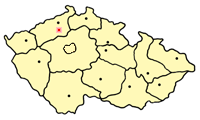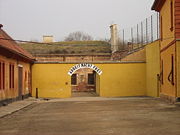
Paradise Camp
Encyclopedia
Paradise Camp is a 1986 documentary
about Theresienstadt concentration camp
in Czechoslovakia
. Unlike other Holocaust camps, Jews
entered Theresianstadt willingly, even eagerly, because Nazi lies led them to believe it would be a peaceful retreat. The deception continued even after it was clear that Theresienstadt was a ghetto. The Nazis used the camp to film a pro-concentration camp propaganda
film and fool Red Cross officials into believing the Jews were being well cared for.
Jews entering Theresienstadt at its opening. “They wanted to make their beautiful spa stay very nice, and, when they arrived in big barracks, they couldn’t understand what happened.”
 Paradise Camp reveals how Nazi deception fooled Jews into entering Theresienstadt willingly. Elderly Jews were fooled into believing the camp would be their safe haven, World War I
Paradise Camp reveals how Nazi deception fooled Jews into entering Theresienstadt willingly. Elderly Jews were fooled into believing the camp would be their safe haven, World War I
veterans thought that their service to Germany
was being rewarded, and prominent Jews thought they were being given special treatment for their German nationalism
, with fine accommodations and protection from the war. But they all found themselves sleeping in overcrowded barracks, eating meager portions of bread, and fearing for their lives. Paradise Camp features interviews with survivors, who experienced the hunger, filth and terror that the Nazi officials worked to mask, and displays old photographs and archival film footage, to reconstruct the truth about Theresienstadt.
Originally a fortress town in Terezin
, Czechoslovakia
, Theresienstadt was built in the 1800s for the Austrian
Empress Maria Theresa. But the Nazis realized the high stone walls that surrounded the city made it an ideal site in which to imprison Jews from Czechoslovakia and its neighboring Eastern European nations. In 1941, the Germans established it as a Jewish ghetto, and a year later they began to deport Jews from Theresienstadt to extermination camps throughout Eastern Europe, including Auschwitz, Majdanek
and Treblinka.
The Nazis turned Theresienstadt into the equivalent of a film set, the Nazis applied a fresh coat of paint to the buildings, cleaned the streets, and brought in ample props for the making of a propaganda film that depicted life at a concentration camp as comfortable and enjoyable. The little old women knit, a small boy waters a garden with an oversized water barrel, and everyone wears a lazy smile and a healthy layer of fat.
 In sharp contradiction to these false images, the documentary also offers the survivors’ memories of what life was really like at Theresienstadt. One woman remembers eating crushed red brick and pretending it was paprika
In sharp contradiction to these false images, the documentary also offers the survivors’ memories of what life was really like at Theresienstadt. One woman remembers eating crushed red brick and pretending it was paprika
, while crushed bark served as an alternative spice. Another woman recalls that before a Red Cross inspection, the Nazis built children’s rooms painted in bright colors and lined with small beds. But the Nazis never told the Red Cross inspectors that the tiny beds were inhabited by seventeen-year-olds, because all the younger children had been murdered.
But, artistically, the survivors also show what life in Theresienstadt was truly like. Some Jews were able to smuggle in paper and pencils and, using these simple resources to their highest advantage, they drew everything they saw. The documentary shows their shocking work. Sketches of victims with sunken eyes, ragged clothes and bony fingers document starvation and need.
Documentary film
Documentary films constitute a broad category of nonfictional motion pictures intended to document some aspect of reality, primarily for the purposes of instruction or maintaining a historical record...
about Theresienstadt concentration camp
Theresienstadt concentration camp
Theresienstadt concentration camp was a Nazi German ghetto during World War II. It was established by the Gestapo in the fortress and garrison city of Terezín , located in what is now the Czech Republic.-History:The fortress of Terezín was constructed between the years 1780 and 1790 by the orders...
in Czechoslovakia
Czechoslovakia
Czechoslovakia or Czecho-Slovakia was a sovereign state in Central Europe which existed from October 1918, when it declared its independence from the Austro-Hungarian Empire, until 1992...
. Unlike other Holocaust camps, Jews
Jews
The Jews , also known as the Jewish people, are a nation and ethnoreligious group originating in the Israelites or Hebrews of the Ancient Near East. The Jewish ethnicity, nationality, and religion are strongly interrelated, as Judaism is the traditional faith of the Jewish nation...
entered Theresianstadt willingly, even eagerly, because Nazi lies led them to believe it would be a peaceful retreat. The deception continued even after it was clear that Theresienstadt was a ghetto. The Nazis used the camp to film a pro-concentration camp propaganda
Propaganda
Propaganda is a form of communication that is aimed at influencing the attitude of a community toward some cause or position so as to benefit oneself or one's group....
film and fool Red Cross officials into believing the Jews were being well cared for.
Summary
“They had nice coats. They brought pictures,” a witness remembers of prominent CzechCzechoslovakia
Czechoslovakia or Czecho-Slovakia was a sovereign state in Central Europe which existed from October 1918, when it declared its independence from the Austro-Hungarian Empire, until 1992...
Jews entering Theresienstadt at its opening. “They wanted to make their beautiful spa stay very nice, and, when they arrived in big barracks, they couldn’t understand what happened.”

World War I
World War I , which was predominantly called the World War or the Great War from its occurrence until 1939, and the First World War or World War I thereafter, was a major war centred in Europe that began on 28 July 1914 and lasted until 11 November 1918...
veterans thought that their service to Germany
Germany
Germany , officially the Federal Republic of Germany , is a federal parliamentary republic in Europe. The country consists of 16 states while the capital and largest city is Berlin. Germany covers an area of 357,021 km2 and has a largely temperate seasonal climate...
was being rewarded, and prominent Jews thought they were being given special treatment for their German nationalism
Nationalism
Nationalism is a political ideology that involves a strong identification of a group of individuals with a political entity defined in national terms, i.e. a nation. In the 'modernist' image of the nation, it is nationalism that creates national identity. There are various definitions for what...
, with fine accommodations and protection from the war. But they all found themselves sleeping in overcrowded barracks, eating meager portions of bread, and fearing for their lives. Paradise Camp features interviews with survivors, who experienced the hunger, filth and terror that the Nazi officials worked to mask, and displays old photographs and archival film footage, to reconstruct the truth about Theresienstadt.
Originally a fortress town in Terezin
Terezín
Terezín is the name of a former military fortress and adjacent walled garrison town in the Ústí nad Labem Region of the Czech Republic.-Early history:...
, Czechoslovakia
Czechoslovakia
Czechoslovakia or Czecho-Slovakia was a sovereign state in Central Europe which existed from October 1918, when it declared its independence from the Austro-Hungarian Empire, until 1992...
, Theresienstadt was built in the 1800s for the Austrian
Austria-Hungary
Austria-Hungary , more formally known as the Kingdoms and Lands Represented in the Imperial Council and the Lands of the Holy Hungarian Crown of Saint Stephen, was a constitutional monarchic union between the crowns of the Austrian Empire and the Kingdom of Hungary in...
Empress Maria Theresa. But the Nazis realized the high stone walls that surrounded the city made it an ideal site in which to imprison Jews from Czechoslovakia and its neighboring Eastern European nations. In 1941, the Germans established it as a Jewish ghetto, and a year later they began to deport Jews from Theresienstadt to extermination camps throughout Eastern Europe, including Auschwitz, Majdanek
Majdanek
Majdanek was a German Nazi concentration camp on the outskirts of Lublin, Poland, established during the German Nazi occupation of Poland. The camp operated from October 1, 1941 until July 22, 1944, when it was captured nearly intact by the advancing Soviet Red Army...
and Treblinka.
The Nazis turned Theresienstadt into the equivalent of a film set, the Nazis applied a fresh coat of paint to the buildings, cleaned the streets, and brought in ample props for the making of a propaganda film that depicted life at a concentration camp as comfortable and enjoyable. The little old women knit, a small boy waters a garden with an oversized water barrel, and everyone wears a lazy smile and a healthy layer of fat.

Paprika
Paprika is a spice made from the grinding of dried fruits of Capsicum annuum . In many European languages, the word paprika refers to bell peppers themselves. The seasoning is used in many cuisines to add color and flavor to dishes. Paprika can range from mild to hot...
, while crushed bark served as an alternative spice. Another woman recalls that before a Red Cross inspection, the Nazis built children’s rooms painted in bright colors and lined with small beds. But the Nazis never told the Red Cross inspectors that the tiny beds were inhabited by seventeen-year-olds, because all the younger children had been murdered.
But, artistically, the survivors also show what life in Theresienstadt was truly like. Some Jews were able to smuggle in paper and pencils and, using these simple resources to their highest advantage, they drew everything they saw. The documentary shows their shocking work. Sketches of victims with sunken eyes, ragged clothes and bony fingers document starvation and need.

